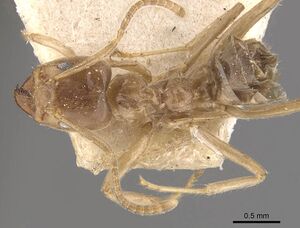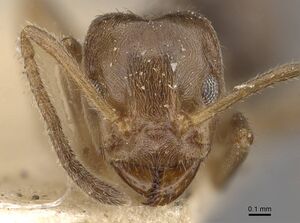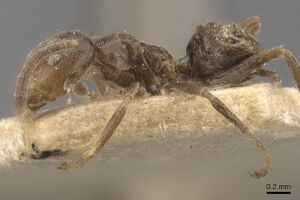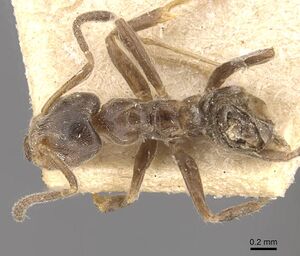Azteca ulei
| Azteca ulei | |
|---|---|

| |
| Scientific classification | |
| Kingdom: | Animalia |
| Phylum: | Arthropoda |
| Class: | Insecta |
| Order: | Hymenoptera |
| Family: | Formicidae |
| Subfamily: | Dolichoderinae |
| Tribe: | Leptomyrmecini |
| Genus: | Azteca |
| Species: | A. ulei |
| Binomial name | |
| Azteca ulei Forel, 1904 | |
| Subspecies | |
| |
| At a Glance | • Ant garden |
Identification
Distribution
Latitudinal Distribution Pattern
Latitudinal Range: -4.033333° to -12°.
| North Temperate |
North Subtropical |
Tropical | South Subtropical |
South Temperate |
- Source: AntMaps
Distribution based on Regional Taxon Lists
Neotropical Region: Brazil (type locality), Peru.
Distribution based on AntMaps
Distribution based on AntWeb specimens
Check data from AntWeb
Countries Occupied
| Number of countries occupied by this species based on AntWiki Regional Taxon Lists. In general, fewer countries occupied indicates a narrower range, while more countries indicates a more widespread species. |

|
Estimated Abundance
| Relative abundance based on number of AntMaps records per species (this species within the purple bar). Fewer records (to the left) indicates a less abundant/encountered species while more records (to the right) indicates more abundant/encountered species. |

|
Biology
Ant Gardens
This species is known to form ant gardens (i.e., they are able to initiate ant gardens or are restricted to ant gardens) (Campbell et al., 2022; Madison, 1979).
Castes
Worker
Images from AntWeb
   
| |
| Syntype of Azteca ulei. Worker. Specimen code casent0909695. Photographer Will Ericson, uploaded by California Academy of Sciences. | Owned by MHNG, Geneva, Switzerland. |
   
| |
| Syntype of Azteca ulei cordiae. Worker (major/soldier). Specimen code casent0909696. Photographer Will Ericson, uploaded by California Academy of Sciences. | Owned by MHNG, Geneva, Switzerland. |
   
| |
| Syntype of Azteca ulei cordiae. Worker. Specimen code casent0909697. Photographer Will Ericson, uploaded by California Academy of Sciences. | Owned by MHNG, Geneva, Switzerland. |
   
| |
| Syntype of Azteca ulei nigricornis. Worker (major/soldier). Specimen code casent0909701. Photographer Will Ericson, uploaded by California Academy of Sciences. | Owned by MHNG, Geneva, Switzerland. |
   
| |
| Syntype of Azteca ulei nigricornis. Worker. Specimen code casent0909702. Photographer Will Ericson, uploaded by California Academy of Sciences. | Owned by MHNG, Geneva, Switzerland. |
Nomenclature
The following information is derived from Barry Bolton's Online Catalogue of the Ants of the World.
- ulei. Azteca ulei Forel, 1904e: 694 (w.) BRAZIL (Amazonas).
- Type-material: syntype workers (number not stated).
- [Note: Shattuck, 1994: 28, cites 7w syntypes MHNG.]
- Type-locality: Brazil: Amazonas, Juruá, Juruá Miry (Mirim), no. 577b (E. Ule).
- Type-depository: MHNG.
- Status as species: Emery, 1913a: 35; Borgmeier, 1923: 97; Wheeler, W.M. & Bequaert, 1929: 35; Wheeler, W.M. 1942: 245; Kempf, 1972a: 35; Shattuck, 1994: 28; Bolton, 1995b: 80; Guénard & Economo, 2015: 226.
- Distribution: Brazil.
- Current subspecies: nominal plus cordiae, gagatina, nigricornis.
Description
References
- Albuquerque, E., Prado, L., Andrade-Silva, J., Siqueira, E., Sampaio, K., Alves, D., Brandão, C., Andrade, P., Feitosa, R., Koch, E., Delabie, J., Fernandes, I., Baccaro, F., Souza, J., Almeida, R., Silva, R. 2021. Ants of the State of Pará, Brazil: a historical and comprehensive dataset of a key biodiversity hotspot in the Amazon Basin. Zootaxa 5001, 1–83 (doi:10.11646/zootaxa.5001.1.1).
- Bulter, I. 2020. Hybridization in ants. Ph.D. thesis, Rockefeller University.
- Campbell, L.C.E., Kiers, E.T., Chomicki, G. 2022. The evolution of plant cultivation by ants. Trends in Plant Science (doi:10.1016/j.tplants.2022.09.005).
- Forel, A. 1904f. In und mit Pflanzen lebende Ameisen aus dem Amazonas-Gebiet und aus Peru, gesammelt von Herrn E. Ule. Zool. Jahrb. Abt. Syst. Geogr. Biol. Tiere 20: 677-707 (page 694, soldier, worker described)
- Franco, W., Ladino, N., Delabie, J.H.C., Dejean, A., Orivel, J., Fichaux, M., Groc, S., Leponce, M., Feitosa, R.M. 2019. First checklist of the ants (Hymenoptera: Formicidae) of French Guiana. Zootaxa 4674, 509–543 (doi:10.11646/zootaxa.4674.5.2).
- Madison, M. 1979. Additional observations on ant-gardens in Amazonas. Selbyana 5, 107–115.
References based on Global Ant Biodiversity Informatics
- Edwards, D.P., M. Hassall, W.J. Sutherland and D.W. Yu. 2006. Assembling a mutualism: ant symbionts locate their host plants by detecting volatile chemicals. Insectes Sociaux 53:172-176
- Wheeler W. M. 1942. Studies of Neotropical ant-plants and their ants. Bulletin of the Museum of Comparative Zoology 90: 1-262.

